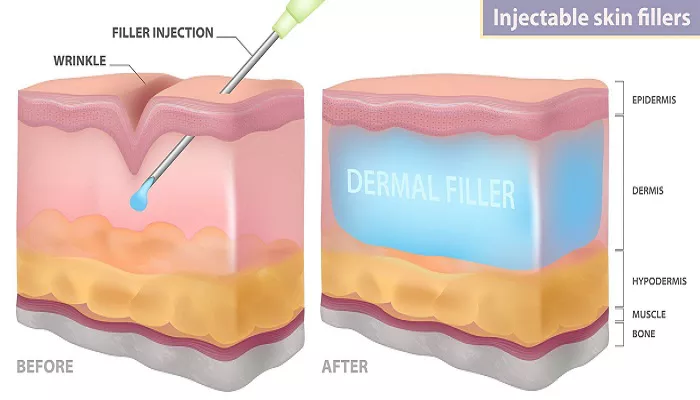Facial fillers have become a popular cosmetic treatment for enhancing facial contours, reducing wrinkles, and restoring volume. However, there are instances where individuals may wish to reverse or adjust the effects of these fillers. Understanding the methods and substances that can dissolve facial fillers is essential for making informed decisions about cosmetic procedures.
What Are Facial Fillers?
Facial fillers, also known as dermal fillers, are injectable substances used to add volume, smooth lines, and enhance facial features. They are commonly used in areas such as the cheeks, lips, and around the mouth.
Types of Facial Fillers
There are several types of facial fillers, each with different properties and longevity:
- Hyaluronic Acid (HA) Fillers: These are the most common and include products like Juvederm and Restylane. They are temporary and can be dissolved if necessary.
- Calcium Hydroxylapatite (CaHA) Fillers: Found in products like Radiesse, these are thicker and last longer but are not easily reversible.
- Poly-L-lactic Acid Fillers: Such as Sculptra, these stimulate collagen production and are not reversible.
- Polymethylmethacrylate (PMMA) Fillers: Found in Bellafill, these are semi-permanent and not reversible.
Reasons for Dissolving Facial Fillers
Individuals may choose to dissolve facial fillers for various reasons:
- Unsatisfactory Results: The outcome may not meet the individual’s expectations.
- Overfilling: Excessive volume can lead to unnatural appearances.
- Asymmetry: Uneven distribution of filler can cause facial imbalance.
- Lumps or Nodules: Formation of palpable or visible lumps under the skin.
- Migration: Filler moving from the original injection site to other areas.
- Complications: Including allergic reactions or vascular occlusion.
Methods to Dissolve Facial Fillers
Hyaluronidase: The Primary Solution
For hyaluronic acid-based fillers, the enzyme hyaluronidase is commonly used to dissolve the filler. Hyaluronidase breaks down hyaluronic acid, allowing the body to absorb and eliminate it naturally. This process is effective and typically shows results within 24 to 48 hours.
Limitations of Hyaluronidase
It’s important to note that hyaluronidase is only effective on hyaluronic acid-based fillers. Fillers made from other substances, such as calcium hydroxylapatite or poly-L-lactic acid, cannot be dissolved with hyaluronidase. In these cases, individuals must wait for the filler to naturally degrade over time or consider other medical interventions.
Natural Dissolution
All fillers will eventually break down and be absorbed by the body. The time frame varies depending on the type of filler used:
- Hyaluronic Acid Fillers: Typically last 6 to 12 months.
- Calcium Hydroxylapatite Fillers: Can last up to 12 months.
- Poly-L-lactic Acid Fillers: Results can last more than 2 years.
- Polymethylmethacrylate Fillers: Considered semi-permanent, lasting 5 years or more.
The Procedure of Dissolving Fillers
Consultation
Before undergoing filler dissolution, a consultation with a qualified medical professional is essential. The practitioner will assess the area, discuss the individual’s concerns, and determine the appropriate course of action.
Administration of Hyaluronidase
If hyaluronidase is deemed suitable, the enzyme is injected directly into the area where the filler was placed. The procedure is relatively quick, often completed within 15 to 30 minutes. Patients may experience mild discomfort, swelling, or bruising at the injection site.
Post-Treatment Care
After the procedure, patients are advised to:
- Avoid Touching the Area: To prevent irritation or infection.
- Apply Cold Compresses: To reduce swelling.
- Follow Up: Attend any scheduled follow-up appointments to assess the results.
Risks and Considerations
While dissolving fillers is generally safe, there are potential risks:
- Allergic Reactions: Though rare, some individuals may react to hyaluronidase.
- Over-Dissolution: Excessive breakdown of filler can lead to volume loss or unevenness.
- Incomplete Dissolution: Multiple sessions may be required to achieve desired results.
It’s crucial to have the procedure performed by an experienced and qualified professional to minimize risks.
Conclusion
Dissolving facial fillers is a viable option for individuals seeking to reverse or adjust the effects of their cosmetic treatments. Hyaluronidase offers an effective solution for hyaluronic acid-based fillers, providing a relatively quick and safe method to address concerns. However, understanding the limitations and potential risks is essential. Consulting with a qualified medical professional ensures that individuals receive appropriate care tailored to their specific needs and goals.
Related topics:


